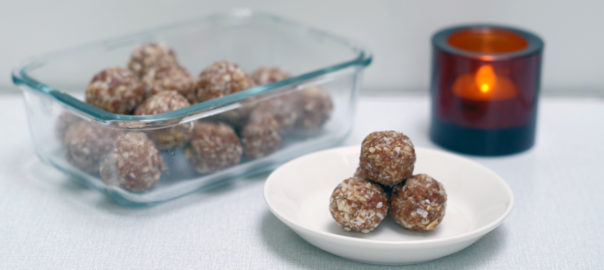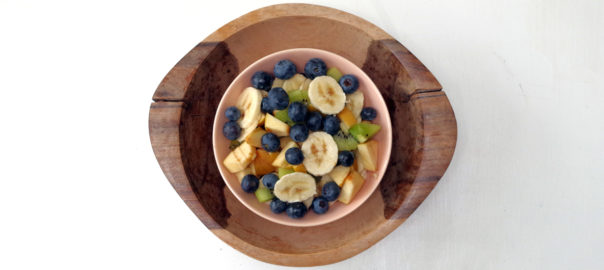Yoga Kitchen – Simple, healthy, and plant-based
Little energy bombs
Dry fruits and nuts belong to the food items with a high energy density.
Firstly, they are very nutritious: they contain many minerals and nuts in particular contain healthy fats. Furthermore, they contain a relatively high amount of energy per unit weight, expressed in calories. You only need to eat a little bit of them to quickly reach a decent calorie intake.
However, calories are only a flawed way of measuring nutritional value. You can read more about that at the end of this post.
In the example below, we combine nuts and dry fruits to create a delicious plant-based snack that you could even eat for breakfast. And all with raw, unprocessed produce, with no added sugars.
What do you need?
The number of balls depends on how big or small you roll them.
You get about a total of 320 grams of finished product with the quantities suggested below.
From this you get about 24 pieces with a diameter of about one and a half centimetres.
Take 80 grams of each of the products listed below:
- pitted tamarind paste
- cashew nuts or white almonds
- grated coconut
- raisins
The tamarind is also called the Indian date. The fruit is also well known in South America and the rest of Southeast Asia. The seeds of the tamarind are rock hard, and these have to be removed. Look carefully on the packaging to make sure you have the pitted version. The pulp of tamarind is sold in packets of about 150g to 200g in Asian and Indian shops. Tamarind has a pleasant, fresh sour-sweet flavour.
This is how you make the energy balls:
- Cut the tamarind paste into smaller pieces with a sharp knife. Remove any remaining seeds.
- Add the nuts to the bowl of a food processor and pulse them to a fine, granular powder.
- Add the grated coconut and pulse a few more times.
- Set the finely ground nut and coconut mixture aside.
- Now add the tamarind and sultanas to the bowl of the food processor and pulse them finely.
- Continue to grind the tamarind and sultanas until a sticky mass with a doughy consistency forms.
- Then knead the fruit mixture and nut-coconut mixture together well with your fingers.
- Roll balls of approximately equal size between your fingers and hands.
- The balls will keep for a full week in a sealed container in the fridge.
Kneading is solid work for fingers and hands! You’ll get muscular forearms!
Take the above recipe as a general model for this kind of healthy snack.
You can make your own combinations from the following ingredients:
- Nuts such as: walnuts, pecans, almonds, cashews, hazelnuts …
- Whole grains such as: buckwheat, oat flakes or other cereal flakes …
- Dried fruits such as: sultanas, cranberries, plums, apricots, figs, dates …
- Spices such as: pepper, cinnamon, nutmeg, cardamom …
Use your creativity and be guided by your tastes and what you have available.
Preferably buy organically grown ingredients in bulk, which further saves packaging waste and is often cheaper.
Approximate nutritional value of these energy balls, per 100g of product:
| Energy | Carbohydrates | Sugars | Fat | Sat. Fat | Protein | Fibre | Salt |
|---|---|---|---|---|---|---|---|
| 459,5 kcal | 48,6 g | 29,8 g | 28,7 g | 15,3 g | 8,5 g | 10,8 g | 0,032 g |
Calorie counting, does it make sense?
The energy value of a food product, expressed in calories, is a theoretically calculated amount of energy that would be released if you were to burn the food product completely to ashes in a closed vessel and then measure how much heat energy is released in the process.
But of course, we humans are not a closed vessel, nor do we burn our food completely to ashes!
Further, the energy from our food acts on our organs in a much more complex way than just heat energy.
As an example, to 1000 kcal steamed cauliflower, your body will react completely differently than to 1000 kcal smarties or some other criminally unhealthy candy.
Furthermore, eating 1000 kcal of food of any kind does not mean that your body will also absorb 1000 kcal of it. Some of your food will digest, some will not. Also depending on what your individual digestive system can handle. Indeed, a lot depends on the condition and diversity of your gut flora.
So calories are very, very relative as a measure of one’s nutritional intake and give little or no relevant information.
They are only useful if you already have a varied and balanced diet.
In the following cases, with a balanced diet, it may possibly make temporary sense to monitor and adjust your calorie intake:
- If your weight is really too low and you need to gain weight for health reasons.
- If your weight is really too high and you need to lose weight for health reasons.
- Or if you want to build muscle or lose fat in a controlled way as part of a strength training programme (body-building).
In these cases, it comes down to eliminating excess or deficiency in nutrition by ajusting portions. Or by changing the ratios between carbohydrates, fats and protein and thus creating a better balance.
What is the right portion size for a meal?
It is a misconception to think that you have to eat your stomach full.
It is sometimes said in Ayurvedic health teachings that you should scoop up a volume of food the size of your two fists per meal on your plate. That makes sense somewhere. After all, our stomach is a very elastic organ. The more we eat, the more the stomach stretches. The bad news is that once stretched, it retains its larger volume, making it easier to eat just a little too much next time. So it becomes a vicious cycle in the long run.
A golden tip for better digestion and health: Chew as long as possible before swallowing.
Read more about plant-based nutrition and health:
Read more articles about nutrition, health and plant-based foods:
Read more about plant-based food
Read more about yoga and yoga classes in Schaerbeek:
Check out our yoga classes here:


